#francesco zuccarelli
Explore tagged Tumblr posts
Text

A classical landscape by Francesco Zuccarelli hangs over the fireplace in the dining room at Saltram House, Devon. Robert Adam worked on the house in the late eighteenth century and first fitted out this room as a library. The plaster picture frame and fire surround display an acute balance of proportion and detail.
The Fireplace, 1994
#vintage#interior design#home#vintage interior#architecture#home decor#style#1990s#90s#living room#fireplace#mantel#Saltram House#Devon#lime green#wall color#Robert Adam#classical#Francesco Zuccarelli
261 notes
·
View notes
Text

Francesco Zuccarelli (Italian, 1702-1788)
Paesaggio con figure
43 notes
·
View notes
Text

Macbeth and the Three Witches by Francesco Zuccarelli
#macbeth#three witches#art#banquo#francesco zuccarelli#shakespeare#william shakespeare#prophecy#scottish#england#scotland#britain#witch#witches#supernatural#landscape#storm#stormy#storms#thunder#lightning#thunderstorm#thunderstorms#night#castle#castles#king#tragedy#sky#clouds
102 notes
·
View notes
Text

Francesco Zuccarelli (Italian, 1702 - 1778), Landscape with the Education of Bacchus, 1744
#18th century#italian art#Francesco Zuccarelli#Bacchus#greek gods#greek myth#greek mythology#landscape#art#art history
9 notes
·
View notes
Video
youtube
Francesco Zuccarelli | il ratto di Europa
#youtube#arte#artesplorando#storia dell'arte#esplorazione#divulgazione#artesplorazioni#audioquadri#francesco zuccarelli
0 notes
Text

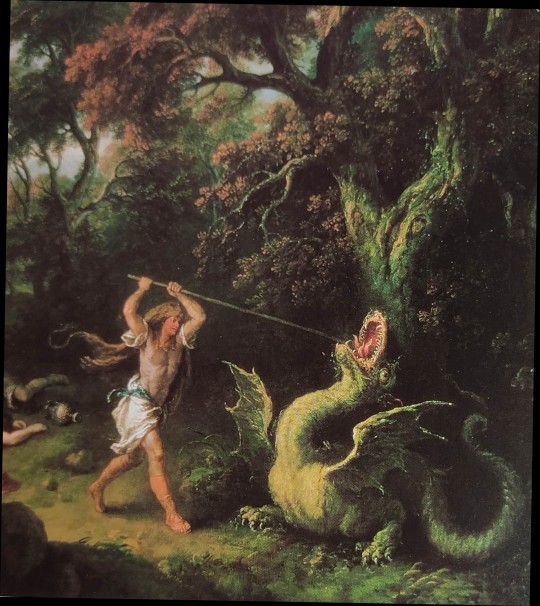
Cadmus Killing the Dragon, 1765 by Francesco Zuccarelli (1702--1788)
1 note
·
View note
Text

Francesco Zuccarelli, 1702-1788
Bellona, Roman goddess of war, 1728, print on paper (after a sculpture by Michelangelo)
V&A South Kensington, London Inv. 25530:7
31 notes
·
View notes
Text
The Dionysos gallery (2)
Next on our travel down the Dionysos museum, we have an entire section dedicated to the Bacchanals in painting - with a few analysis here and there.
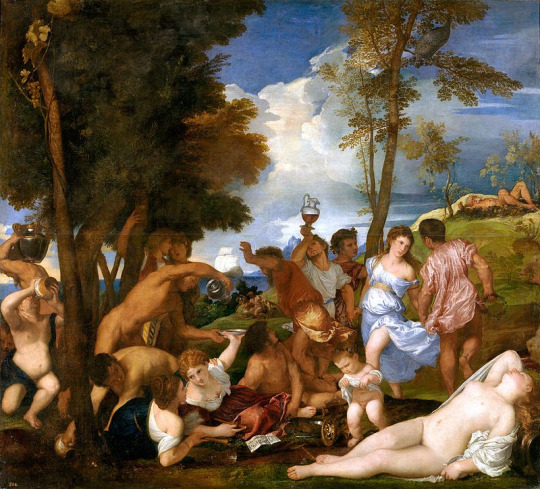
Titien's The Bacchanal of the Andrians
The Museum's website adds that this depicts the legend of how Dionysos gifted the inhabitants of the island of Andros with a river of wine. It was one of the numerous "miracles" attributed to the god by folk-belief when he became the god of the grapevine. Already in his "Bacchants" Euripides had told how, by touching a stone with his thyrsus he created a stream of fresh water, and where his narthex had touched the ground a stream of wine flowed ; and those that sought milk only had to scratch the ground near the god to see it flow, and from the god's thyrsus honey dropped...
In Ionia, on the island of Teos, a similar legend existed: it was said, by Diodor of Sicily and Pline the Elder, that at a fixed date in a calendar a stream of wine regularly flowed. At Elis, on the eve of the god's feast-day, empty jars and jugs were sealed and left alone in Dionysos' temple: by the morning, when they were opened, they were filled to the brim with wine.
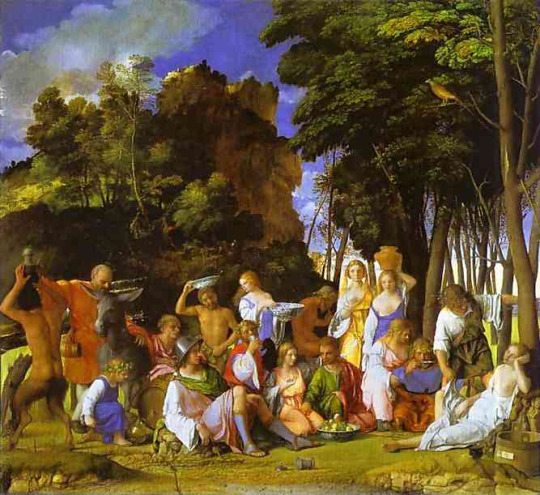
Giovanni Bellini and Titien's The Feast of the Gods
The museum adds this mention: the painting is a depiction of the legend of Lotis collected by Ovid. One night, as the gods had a feast, the nymph Lotis fell asleep. Priapus got close to her, and with his famous ithyphallic nature, he decided to rape her. But as he was about to touch her body, the donkey of Silenus started making loud noises - waking up everybody, including Lotis. Lotis fled from Priapus' embrace, and all the gods laughed and mocked the god.
This painting was most notably the favorite painting of Fernand Botero.

Dosso Dossi's Bacchanal with a drunk Silenus and Bacchants frolicking around grapevine
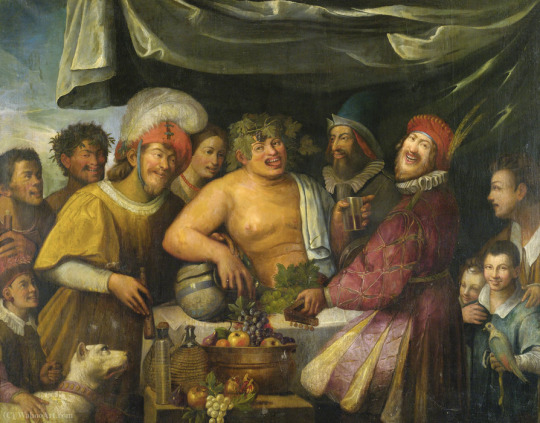
Niccolo Frangipane's Bacchanal

Nicolas Poussin's Bacchanal
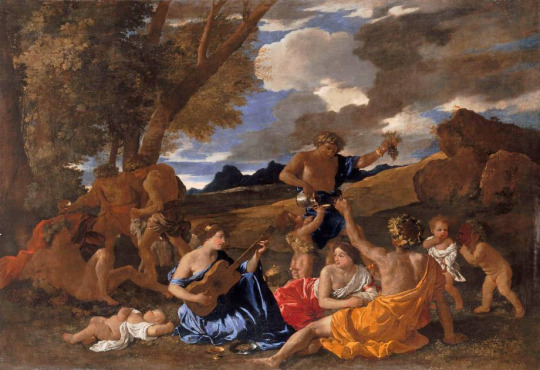
Nicolas Poussin's Bacchanal with a guitar player ; also called "Great Bacchanal"
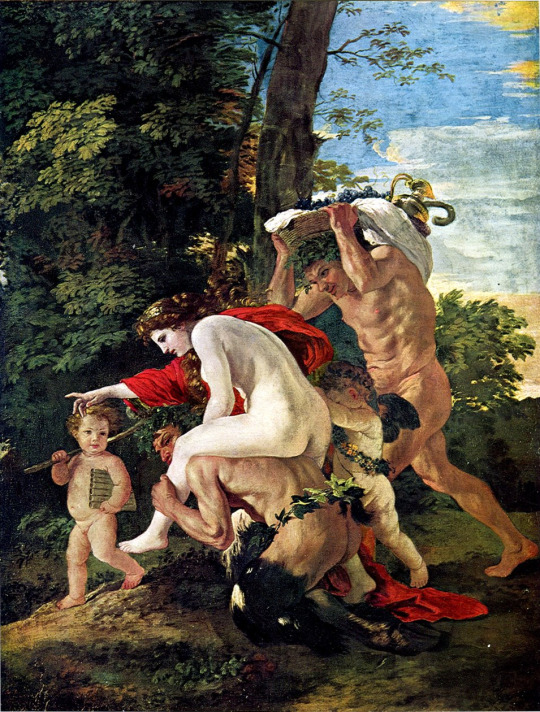
Nicolas Poussin's Bacchic Scene

Pier Francesco Mola's Bacchus supervising the Satyrs pressing wine
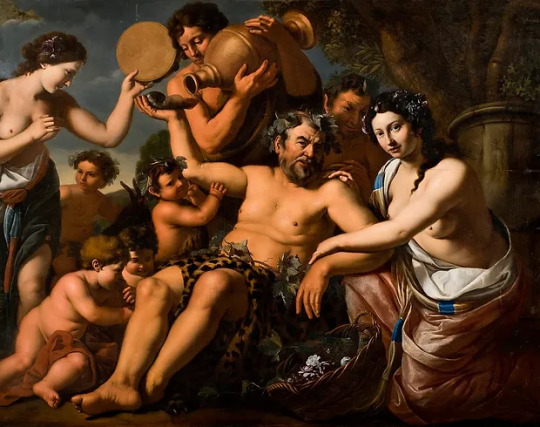
Gerrit van Bronckhorst's Bacchanal with Silenus
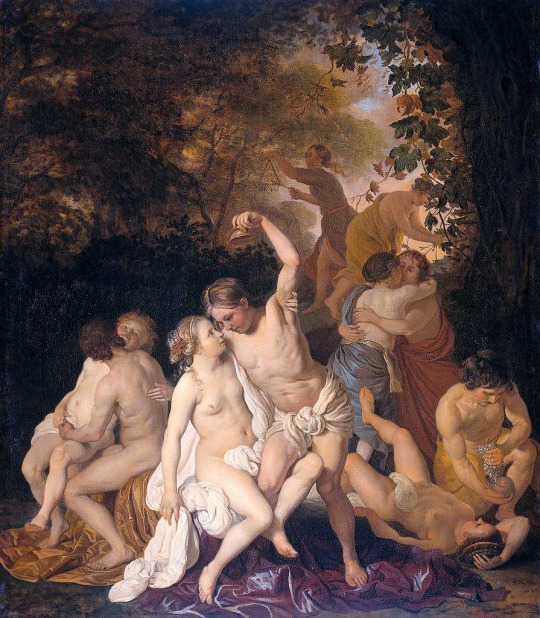
Jacob van Loo's Scene with Bacchants

Michaelina Wautier's Bacchanal
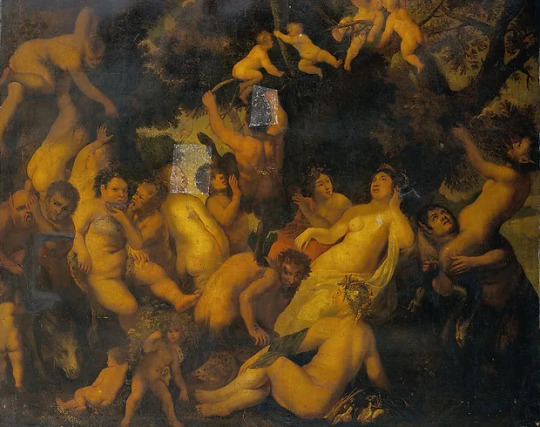
Jacques Jordaens' Bacchanal
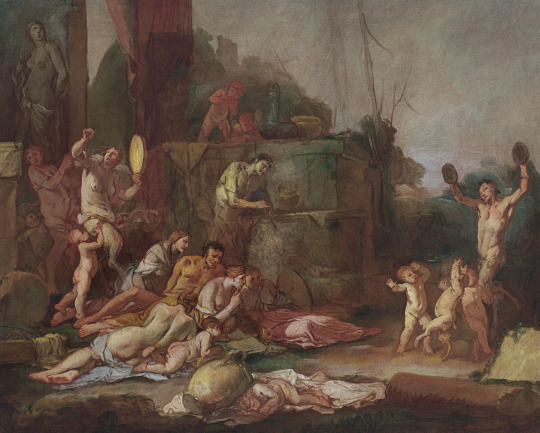
Giulio Carpioni's Bacchanal
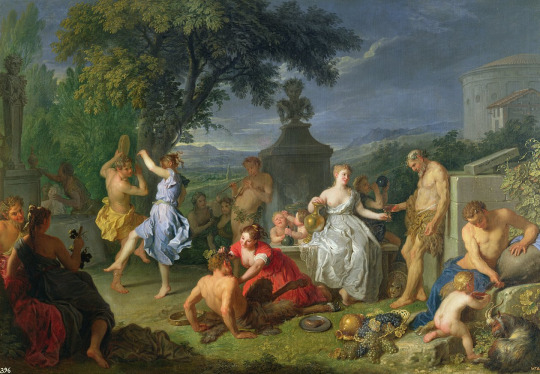
Michel-Ange Houasse's Bacchanal
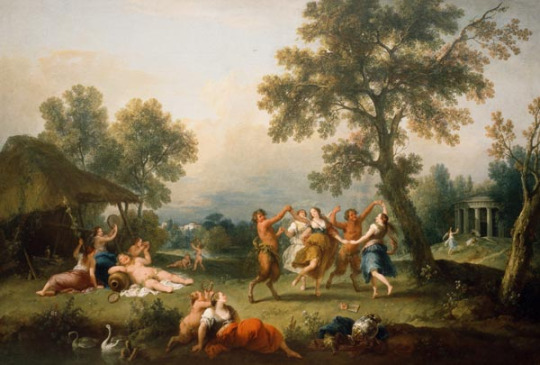
Francesco Zuccarelli's Bacchanal
#dionysos#the art of the myth#dionysus#bacchanal#the dionysos gallery#silenus#bacchants#greek mythology#painting#art
52 notes
·
View notes
Text

"Landscape with the Education of Bacchus" by Francesco Zuccarelli
From what I've read so far on Hyrsam, the Archfey, he seems to be a mix between Pan and Dionysus (if we're sticking strictly to classical mythology). So I am assuming his retinue is very, very, very, very much like the Bacchante/Maenads which is such a WIN in terms of glamor. Here are some paintings for inspiration for the Feywild's favorite Prince of Fools.
More paintings below the cut!

"The Triumph of Bacchus" by Nicolas Poissin
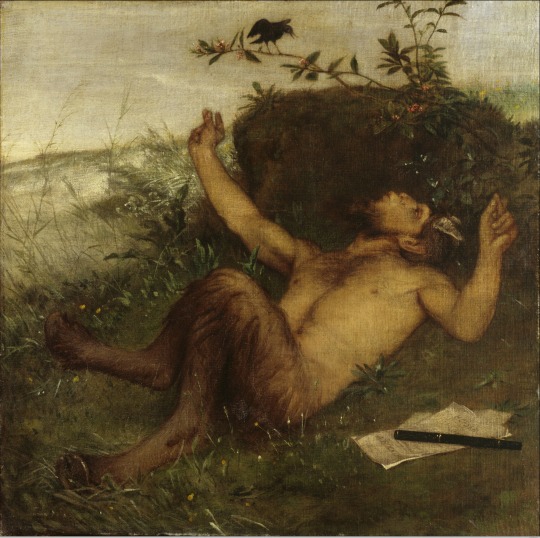
"Faun einer Amsel zupfeifend" by Arnold Böcklin

"Faun, die Syrinx blasend" by Arnold Böcklin

"Pan im Schlif" by Arnold Böcklin
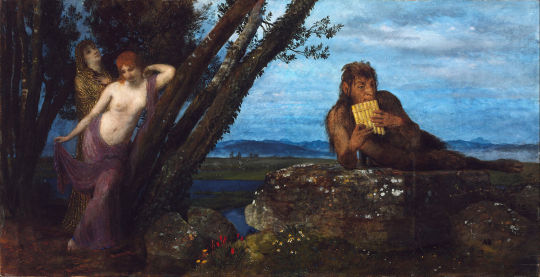
"Spring Evening" by Arnold Böcklin
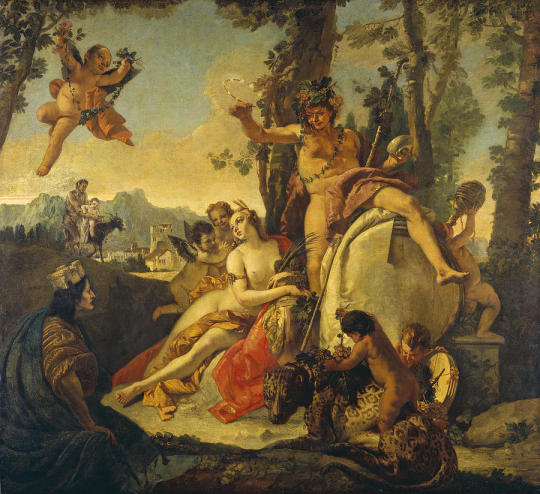
"Bacchus and Ariadne #2" by Giovanni Battista Tiepolo

"Cupid and Pan" by Agostino Carracci

"Silene and Dionysus" attributed to the French School of the 18th century
3 notes
·
View notes
Text

Three's a Crowd . 18 December 2024 . Landscape with Fountain, Figures and Animals . Giacomo Francesco Zuccarelli
Artist: Zuccarelli, Francesco Date: Before 1788 Dimensions: 99 x 124 Medium: Oil on canvas Copyright: © Dulwich Picture Gallery
Giacomo Francesco Zuccarelli (commonly known as Francesco Zuccarelli), was an Italian artist of the late Baroque or Rococo period. He is considered to be the most important landscape painter to have emerged from his adopted city of Venice during the mid-eighteenth century, and his Arcadian views became popular throughout Europe and especially in England where he resided for two extended periods. His patronage extended to the nobility, and he often collaborated with other artists such as Antonio Visentini and Bernardo Bellotto. In 1768, Zuccarelli became a founding member of the Royal Academy of Arts, and upon his final return to Italy, he was elected president of the Venetian Academy. In addition to his rural landscapes which frequently incorporated religious and classical themes, Zuccarelli created devotional pieces and on occasion did portraiture. Beside paintings, his varied output included etchings, drawings, and designs for tapestries as well as a set of Old Testament playing cards.
Despite the fame he experienced in his lifetime, Zuccarelli's reputation declined in the early 19th century with naturalism becoming increasingly favoured in landscapes. Turner criticized him in mild terms while confessing that his figures could be beautiful, paving the way for more severe Victorian assessments. In 1959, the art historian Michael Levey offered suggestions for why Zuccarelli held such wide contemporary appeal among the English, concluding that his best work is highly decorative. More recently, since the 1990s there has been a renewed focus on Zuccarelli among Italian scholars, who have given him prominence in several books and articles, and his paintings and drawings are regularly shown in exhibitions.
0 notes
Text

Francesco Zuccarelli (Italian, 1702-1788)
Paesaggio con rovine e figure
41 notes
·
View notes
Text
agatha all along painting!
La pintura que aparece cuando Agatha est�� hablando con Teen, es Macbeth y Las tres brujas pintada por Francesco Zuccarelli, que es en el inicio de la obra, cuando con Baquo, las brujas le dicen a Macbeth que será Rey, lo que desencadena toda la tragedia futura de él, sucumbiendo ante la ambición y la avaricia de más poder. Debería de estar representando la presencia de Mephisto quizá, porque justamente, estas brujas supuestamente representan al Diablo y a las conjuraciones pecaminosas. Es imporptante que Agatha y Teen estén juntos, porque al igual que en el libro, solo Macbeth sucumbe y no Baquo, y estaría genial ver a quién esa ambición del Sendero va a consumir, y quién no se va a dejar cegar por el poder.

0 notes
Text
Holidays 8.15
Holidays
Acadian Day (Canada)
Air Conditioning Appreciation Days end
Armed Forces Day (Poland)
Asunción Foundation Day (Paraguay)
Awa Dance Festival (Japan)
Best Friend's Day
Cass Elliot Day (Baltimore, Maryland)
Caveernova Awareness Day (UK)
Chant at the Moon Day
Chauvin Day (a.k.a. Nicolas Chauvin Day)
Check the Chip Day
City Hall Selfie Day
Constitution Day (Equatorial Guinea)
Dog Days of Summer end
815 Day
Ferragosto (Oven of August; Italy)
Flooding of the Nile (Egypt)
Flower Festival begins (Colombia)
Fool’s Dance (Japan)
Green Data Day
Hello Day
I Love Cowboys and Cowgirls Day
International Apostrophe Day
International Neonatal Nurses Day
International Play Lax Day
Jogukhaebangui nal (a.k.a. Fatherland Liberation Day; North Korea)
Khalistan Day
La Vieja Day (Panama)
Loaded Dice Day
Lupin Day (French Republic)
Memorial Day For the End of the War (終戦記念日 Shūsen-kinenbi; Japan)
Moms Equal Pay Day 2023 ( website )
Mother’s Day (Antwerp, Belgium)
National Back-to-School Prep Day
National Day (Liechtenstein)
National Failures Day
National Jean Day
National Leathercraft Day
National Liberation Day of Korea
National Mourning Day (Bangladesh)
National No Spongebob Day (SpongeBob)
National Philip Day
National Relaxation Day
National Sunflower Day (Canada)
Neighbor’s Day (Mexico)
Oscar Peterson Day
Panama Canal Day
Panama La Vieja Day (Panama)
Rockford Day (Illinois)
Sandakan Day (Malaysia)
Sang Marie (Gambia)
Shoro Nagashi Nagasaki (Japan)
Sit Back and Relax Day
SJS Memorial Day
Staatsfeiertag (Liechtenstein)
Stadium Rock Day
Tuva Republic Day (Russia)
Velika Gospa (Croatia)
Victory Over Japan Day (UK)
Woodstock Day
World Child Abuse & Neglect Awareness Day
World Reiki Day
World Greatness Day
Wow! Signal Anniversary Day
Food & Drink Celebrations
National Fresh Poke Day
National Ginseng Day
National Lemon Meringue Pie Day
3rd Tuesday in August
International Chalk the Walks Day [3rd Tuesday]
Independence Days
Gwangbokjeol or Kwang Bok Jul (Liberation Day; South Korea, redeclared independence from Japan; 1945)
Bahrain (from UK, 1971)
India (from UK, 1947)
Republic of the Congo (from Belgium, 1960)
Feast Days
Alypius of Thagaste (a.k.a. Alipius; Christian; Saint)
Assumption (a.k.a. ...
Assomption (Belgium, Croatia, Haiti, Slovenia)
Feast of the Assumption
Feast of the Assumption of Mary
Fête Nationale of the Acadians (Canada)
Assumption of the Blessed Virgin Mary
Feast of the Dormition of the Theotokos (Eastern Orthodox, Oriental Orthodox and Eastern Catholic Churches)
Feast of Saint Mary the Virgin
Feralia X (Day of Purification; Pagan)
Festival of the Outremeuse (Liege, Belgium)
Ferragosto (Italy)
Holy Day of Obligation (Catholic Church)
Irmandade da Nossa Senhora da Boa Morte Fiesta (Festival of the Order of Our Lady of the Good Death; Bahia, Brazil)
Lady's Day (Ireland)
Lunes siguiente a la Asunción de la Virgen (Spain)
Māras (Latvia)
Marilyn Chambers Day (Church of the SubGenius; Saint)
Mother's Day (Antwerp and Costa Rica)
National Acadian Day (Acadians)
Navy Day (Romania)
Virgin of Candelaria, patron of the Canary Islands. (Tenerife, Spain)
Zoline (Lithuania)
Bob (Muppetism)
Bon Festival (a.k.a. Obon; Japan)
Condom Day (Pastafarian)
Feast of the Formation of the Theotokos (Eastern Orthodox)
Festival of Vesta (Ancient Roman Goddess of the Hearth)
Francesco Zuccarelli (Artology)
Great Mother Goddess Day
Herbal Holy Day
Maras Diena (Ancient Latvia)
McCartin (Christian; Saint)
San La Muerte (Paraguayan Folk Catholicism)
Santa Muerte (Mexican Folk Catholicism)
Sproshinki (Slavic Pagan End of the Hay Harvest Festival)
Stanislaus Kostka (Christian; Saint)
Tarcisius (Christian; Saint)
Vasco de Gama (Positivist; Saint)
Wafaa El-Nil (a.k.a. Flooding of the Nile; Ancient Egypt)
Lucky & Unlucky Days
Butsumetsu (仏滅 Japan) [Unlucky all day.]
Fatal Day (Pagan) [16 of 24]
Historically Bad Day (Buddha died & 6 other tragedies) [6 of 11]
Perilous Day (13th Century England) [23 of 32]
Prime Number Day: 227 [49 of 72]
Unfortunate Day (Pagan) [42 of 57]
Premieres
Alice’s Tin Pony (Disney Cartoon; 1925)
American Splendor (Film; 2003)
Americathon (Film; 1979)
Apocalypse Now (Film; 1979)
Bambi, a Life in the Woods, by Felix Salten (Novel; 1922)
Batman and Harley Quinn (WB Animated Film; 2017)
Cat’s Paw (WB LT Cartoon; 1959)
Crazy Rich Asians (Film; 2018)
Dancing Queen, by ABBA (Song; 1976)
Fly Me to the Moon (Animated Film; 2008)
The Full Monty (Film; 1997)
Garbage, by Garbage (Album; 1995)
How to Read a Book, by Mortimer J. Adler & Charles Van Doren (Book; 1972)
I Me ine, by George Harrison (Autobiography; 1980)
In Through the Out Door, by Led Zeppelin (Album; 1979)
The Larry Sanders Show (TV Series; 1992)
Living My Life, by Emma Goldman (Biography; 1931)
Macarena, by Los del Rio (Song; 1993)
Make Mine Music (Animated Disney Film; 1946)
Notorious (Film; 1946)
A Place in the Sun (Film; 1951)
Player Piano, by Kurt Vonnegut Jr. (Novel; 1952)
The Sinking of Lusitania (Windsor McKay Cartoon; 1918)
Star Wars: The Clone Wars (Animated Film; 2008)
Vicky Cristina Barcelona (Film; 2008)
The Wizard of Oz (Film; 1939)
Wizard’s First Rule, by Terry Goodkind (Novel; 1994)
Woodstock Festival begins (Music Festival; 1969)
You Shook Me All Night Long, by AC/DC (Song; 1980)
Today’s Name Days
Maria Himmelfahrt, Tarsitius (Austria)
Mariya (Bulgaria)
Julijana, Mara, Marija (Croatia)
Hana (Czech Republic)
Maria (Denmark)
Hanna, Jaana, Jaanika, Jana, Janika, Janne, Jenny, Johanna, Nanna (Estonia)
Jaana, Jatta, Marianna, Marianne, Marita, Maritta, Marja, Marjaana, Marjatta, Marjo, Marjukka, Marjut (Finland)
Alfred, Marie (France)
Maria Himmelfahrt, Steven (Germany)
Despoina, Maria, Panagiotis, Panayotis (Greece)
Mária (Hungary)
Assunta, Maria (Italy)
Dzelde, Zamuels, Zenta (Latvia)
Napalys, Napoleonas, Sigita, Visvilas, Vydenė (Lithuania)
Margot, Marielle, Mary (Norway)
Maria, Napoleon, Stefan, Stella, Trzebimir (Poland)
Marcela (Slovakia)
Alba, Asunción, Azucena, Mar, María, Patrocinio, Prado, Reyes (Spain)
Estelle, Stella (Sweden)
Madonna, Malia, Mara, Maria, Mariah, Marian, Mariana, Maribel, Marie, Marisa, Marissa, Maritza, Marla, Mary, Maryann, Mimi, Miriam, Mitzy, Molly, Napoleon, Polly (USA)
Today is Also…
Day of Year: Day 227 of 2024; 138 days remaining in the year
ISO: Day 2 of week 33 of 2023
Celtic Tree Calendar: Coll (Hazel) [Day 8 of 28]
Chinese: Month 6 (Ji-Wei), Day 29 (Yi-Si)
Chinese Year of the: Rabbit 4721 (until February 10, 2024)
Hebrew: 28 Av 5783
Islamic: 28 Muharram 1445
J Cal: 17 Hasa; Threesday [17 of 30]
Julian: 2 August 2023
Moon: 1%: Waning Crescent
Positivist: 3 Gutenberg (9th Month) [Vasco de Gama]
Runic Half Month: As (Gods) [Day 3 of 15]
Season: Summer (Day 55 of 94)
Zodiac: Leo (Day 24 of 31)
0 notes
Text
Holidays 8.15
Holidays
Acadian Day (Canada)
Air Conditioning Appreciation Days end
Armed Forces Day (Poland)
Asunción Foundation Day (Paraguay)
Awa Dance Festival (Japan)
Best Friend's Day
Cass Elliot Day (Baltimore, Maryland)
Caveernova Awareness Day (UK)
Chant at the Moon Day
Chauvin Day (a.k.a. Nicolas Chauvin Day)
Check the Chip Day
City Hall Selfie Day
Constitution Day (Equatorial Guinea)
Dog Days of Summer end
815 Day
Ferragosto (Oven of August; Italy)
Flooding of the Nile (Egypt)
Flower Festival begins (Colombia)
Fool’s Dance (Japan)
Green Data Day
Hello Day
I Love Cowboys and Cowgirls Day
International Apostrophe Day
International Neonatal Nurses Day
International Play Lax Day
Jogukhaebangui nal (a.k.a. Fatherland Liberation Day; North Korea)
Khalistan Day
La Vieja Day (Panama)
Loaded Dice Day
Lupin Day (French Republic)
Memorial Day For the End of the War (終戦記念日 Shūsen-kinenbi; Japan)
Moms Equal Pay Day 2023 ( website )
Mother’s Day (Antwerp, Belgium)
National Back-to-School Prep Day
National Day (Liechtenstein)
National Failures Day
National Jean Day
National Leathercraft Day
National Liberation Day of Korea
National Mourning Day (Bangladesh)
National No Spongebob Day (SpongeBob)
National Philip Day
National Relaxation Day
National Sunflower Day (Canada)
Neighbor’s Day (Mexico)
Oscar Peterson Day
Panama Canal Day
Panama La Vieja Day (Panama)
Rockford Day (Illinois)
Sandakan Day (Malaysia)
Sang Marie (Gambia)
Shoro Nagashi Nagasaki (Japan)
Sit Back and Relax Day
SJS Memorial Day
Staatsfeiertag (Liechtenstein)
Stadium Rock Day
Tuva Republic Day (Russia)
Velika Gospa (Croatia)
Victory Over Japan Day (UK)
Woodstock Day
World Child Abuse & Neglect Awareness Day
World Reiki Day
World Greatness Day
Wow! Signal Anniversary Day
Food & Drink Celebrations
National Fresh Poke Day
National Ginseng Day
National Lemon Meringue Pie Day
3rd Tuesday in August
International Chalk the Walks Day [3rd Tuesday]
Independence Days
Gwangbokjeol or Kwang Bok Jul (Liberation Day; South Korea, redeclared independence from Japan; 1945)
Bahrain (from UK, 1971)
India (from UK, 1947)
Republic of the Congo (from Belgium, 1960)
Feast Days
Alypius of Thagaste (a.k.a. Alipius; Christian; Saint)
Assumption (a.k.a. ...
Assomption (Belgium, Croatia, Haiti, Slovenia)
Feast of the Assumption
Feast of the Assumption of Mary
Fête Nationale of the Acadians (Canada)
Assumption of the Blessed Virgin Mary
Feast of the Dormition of the Theotokos (Eastern Orthodox, Oriental Orthodox and Eastern Catholic Churches)
Feast of Saint Mary the Virgin
Feralia X (Day of Purification; Pagan)
Festival of the Outremeuse (Liege, Belgium)
Ferragosto (Italy)
Holy Day of Obligation (Catholic Church)
Irmandade da Nossa Senhora da Boa Morte Fiesta (Festival of the Order of Our Lady of the Good Death; Bahia, Brazil)
Lady's Day (Ireland)
Lunes siguiente a la Asunción de la Virgen (Spain)
Māras (Latvia)
Marilyn Chambers Day (Church of the SubGenius; Saint)
Mother's Day (Antwerp and Costa Rica)
National Acadian Day (Acadians)
Navy Day (Romania)
Virgin of Candelaria, patron of the Canary Islands. (Tenerife, Spain)
Zoline (Lithuania)
Bob (Muppetism)
Bon Festival (a.k.a. Obon; Japan)
Condom Day (Pastafarian)
Feast of the Formation of the Theotokos (Eastern Orthodox)
Festival of Vesta (Ancient Roman Goddess of the Hearth)
Francesco Zuccarelli (Artology)
Great Mother Goddess Day
Herbal Holy Day
Maras Diena (Ancient Latvia)
McCartin (Christian; Saint)
San La Muerte (Paraguayan Folk Catholicism)
Santa Muerte (Mexican Folk Catholicism)
Sproshinki (Slavic Pagan End of the Hay Harvest Festival)
Stanislaus Kostka (Christian; Saint)
Tarcisius (Christian; Saint)
Vasco de Gama (Positivist; Saint)
Wafaa El-Nil (a.k.a. Flooding of the Nile; Ancient Egypt)
Lucky & Unlucky Days
Butsumetsu (仏滅 Japan) [Unlucky all day.]
Fatal Day (Pagan) [16 of 24]
Historically Bad Day (Buddha died & 6 other tragedies) [6 of 11]
Perilous Day (13th Century England) [23 of 32]
Prime Number Day: 227 [49 of 72]
Unfortunate Day (Pagan) [42 of 57]
Premieres
Alice’s Tin Pony (Disney Cartoon; 1925)
American Splendor (Film; 2003)
Americathon (Film; 1979)
Apocalypse Now (Film; 1979)
Bambi, a Life in the Woods, by Felix Salten (Novel; 1922)
Batman and Harley Quinn (WB Animated Film; 2017)
Cat’s Paw (WB LT Cartoon; 1959)
Crazy Rich Asians (Film; 2018)
Dancing Queen, by ABBA (Song; 1976)
Fly Me to the Moon (Animated Film; 2008)
The Full Monty (Film; 1997)
Garbage, by Garbage (Album; 1995)
How to Read a Book, by Mortimer J. Adler & Charles Van Doren (Book; 1972)
I Me ine, by George Harrison (Autobiography; 1980)
In Through the Out Door, by Led Zeppelin (Album; 1979)
The Larry Sanders Show (TV Series; 1992)
Living My Life, by Emma Goldman (Biography; 1931)
Macarena, by Los del Rio (Song; 1993)
Make Mine Music (Animated Disney Film; 1946)
Notorious (Film; 1946)
A Place in the Sun (Film; 1951)
Player Piano, by Kurt Vonnegut Jr. (Novel; 1952)
The Sinking of Lusitania (Windsor McKay Cartoon; 1918)
Star Wars: The Clone Wars (Animated Film; 2008)
Vicky Cristina Barcelona (Film; 2008)
The Wizard of Oz (Film; 1939)
Wizard’s First Rule, by Terry Goodkind (Novel; 1994)
Woodstock Festival begins (Music Festival; 1969)
You Shook Me All Night Long, by AC/DC (Song; 1980)
Today’s Name Days
Maria Himmelfahrt, Tarsitius (Austria)
Mariya (Bulgaria)
Julijana, Mara, Marija (Croatia)
Hana (Czech Republic)
Maria (Denmark)
Hanna, Jaana, Jaanika, Jana, Janika, Janne, Jenny, Johanna, Nanna (Estonia)
Jaana, Jatta, Marianna, Marianne, Marita, Maritta, Marja, Marjaana, Marjatta, Marjo, Marjukka, Marjut (Finland)
Alfred, Marie (France)
Maria Himmelfahrt, Steven (Germany)
Despoina, Maria, Panagiotis, Panayotis (Greece)
Mária (Hungary)
Assunta, Maria (Italy)
Dzelde, Zamuels, Zenta (Latvia)
Napalys, Napoleonas, Sigita, Visvilas, Vydenė (Lithuania)
Margot, Marielle, Mary (Norway)
Maria, Napoleon, Stefan, Stella, Trzebimir (Poland)
Marcela (Slovakia)
Alba, Asunción, Azucena, Mar, María, Patrocinio, Prado, Reyes (Spain)
Estelle, Stella (Sweden)
Madonna, Malia, Mara, Maria, Mariah, Marian, Mariana, Maribel, Marie, Marisa, Marissa, Maritza, Marla, Mary, Maryann, Mimi, Miriam, Mitzy, Molly, Napoleon, Polly (USA)
Today is Also…
Day of Year: Day 227 of 2024; 138 days remaining in the year
ISO: Day 2 of week 33 of 2023
Celtic Tree Calendar: Coll (Hazel) [Day 8 of 28]
Chinese: Month 6 (Ji-Wei), Day 29 (Yi-Si)
Chinese Year of the: Rabbit 4721 (until February 10, 2024)
Hebrew: 28 Av 5783
Islamic: 28 Muharram 1445
J Cal: 17 Hasa; Threesday [17 of 30]
Julian: 2 August 2023
Moon: 1%: Waning Crescent
Positivist: 3 Gutenberg (9th Month) [Vasco de Gama]
Runic Half Month: As (Gods) [Day 3 of 15]
Season: Summer (Day 55 of 94)
Zodiac: Leo (Day 24 of 31)
0 notes
Photo

Francesco Zuccarelli (1702 - 1788)
A Landscape with the Story of Cadmus Killing the Dragon
2 notes
·
View notes
Text

Francesco Zuccarelli, 1702-1788
Diana and Callisto, with Nymphs resting from the hunt, n/d, oil on canvas, 62.2x50 cm
Private Collection (Sotheby's)
17 notes
·
View notes